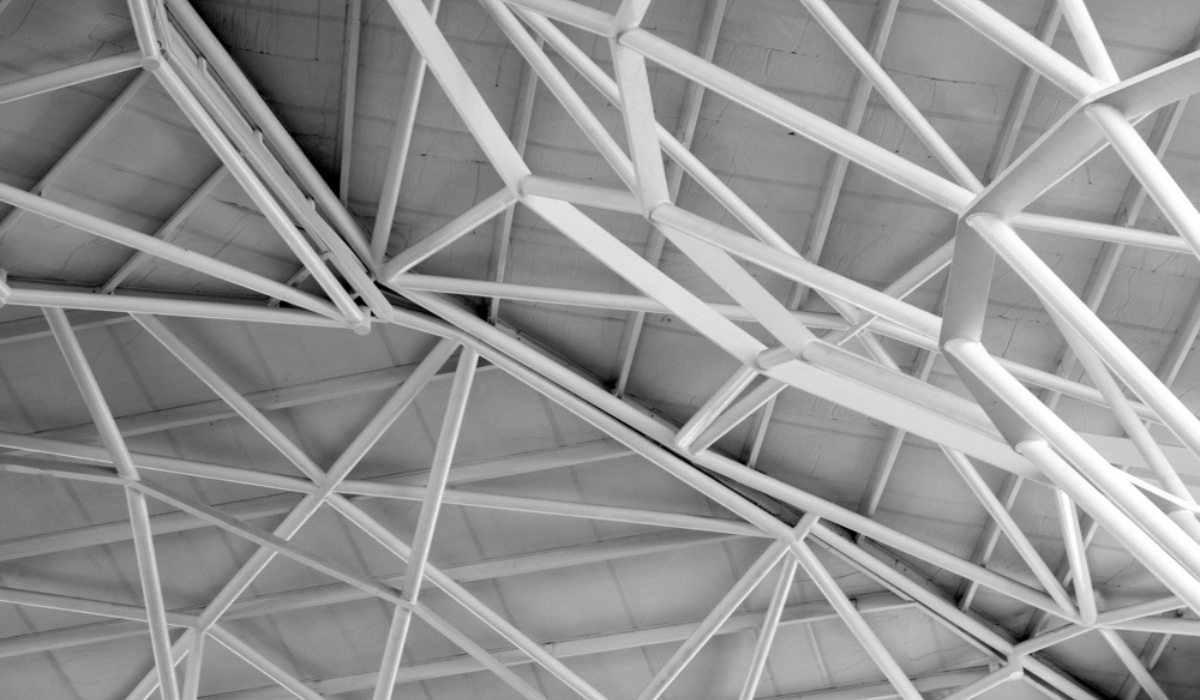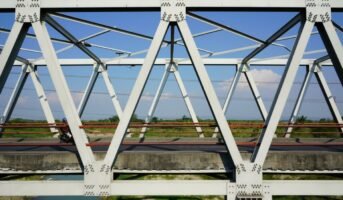A space frame or space structure is a truss-like structure with struts that are connected in a geometric pattern to combine strength and lightness.This is the latest building and construction technology that can effectively cover large areas with little internal support. Learn more about the meaning, uses and types of space frames in construction.
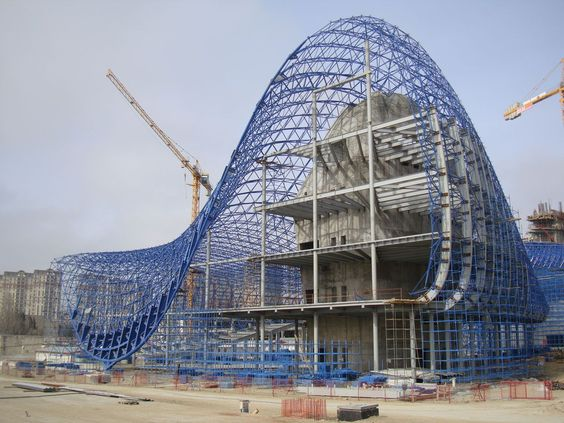
Source: Pinterest
See also: PEB structure: Components, pros and cons of pre-engineered buildings
Space frame: Who discovered it?
Between 1898 and 1908, Alexander Graham Bell invented a space framework based on the geometry of the tetrahedron. Bell’s main claim lies in the manufacture of rigid frames for marine and aeronautical engineering, and the tetrahedral truss is one of his inventions. Max Mengeringhausen started using Graham Bell’s framework of spaces in architecture in 1943 in Germany. In this framework, he developed his system of grids he called MEngeringhausen Rohrbauweise. Typical methods still in use today are individual tubular elements (spherical) connected by nodal joints and variations such as space deck systems, octet truss systems and cubic systems.
Space frame: Components
The space frame structure has various components consisting of linear action elements and node connectors. Linear breaking bars are mainly circular and rectangular. Pipes or pipe sections are used in space frame systems because they can be easily assembled using node connectors. Node connectors are often used to connect one of many connections on an element. The structure is loaded axially and all applied structural loads are transmitted through nodal connections only.
It is very important that the knot connection is very strong and rigid so that it can withstand structural loads. Simple prefabricated units of space frame construction in standard sizes and shapes are available on the market.
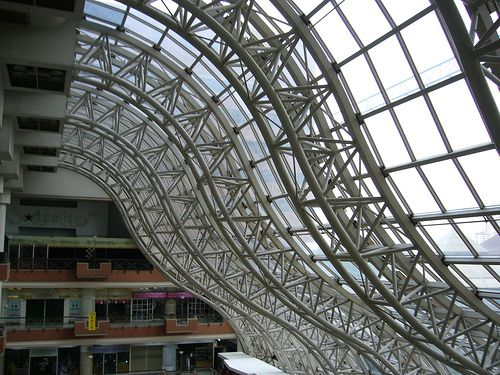
Source: Pinterest
Space frame: Types
Various kinds of space frames are available. Here are the detailed types.
Types of space frames based on curvature
- Space plan covers: Space plan covers are mostly composed of two-dimensional substructures. The level is designed by a horizontal bar and the diagonal absorbs lateral forces.
- Barrel vaults: A barrel vault’s cross-section takes after a simple arch, with tetrahedral modules or pyramids usually used as unit components.
- Spherical domes: The spherical dome is assembled from a complex network of steel sections. Tetrahedral modules or pyramids that support skins are used in this type.
Types of space frames based on arrangements of dome elements
- Single layer grid: All elements are placed on the surface approximately.
- Double layer grid: Space frames often use this type of frame, where the elements are arranged in two parallel layers which are spaced a specific distance from each other. There are many diagonal bars binding the nodes of both layers.
- Triple layer grid: These are arranged in three parallel lines and diagonal lines connect them. They are often flat and are mainly used in long-span buildings.
Space frame: Applications
The space frame is used in various areas. Some of those are mentioned below.
- Commercial and industrial buildings
- Conference hall
- Auditoriums
- Warehouses
- Skylights
- Shopping malls
- Canopies
- Airports
- Aeroplane hangars
- Toll booths
- Exhibition centres
- Sports stadiums
Examples of space frame structures
- Taiwan Taoyuan International Airport terminal 2
- Eden Project in Cornwall, England
- Stansted Airport, by Foster Partners
- Jacob K. Javits Convention Center, New York City, New York
- Entrance to Six Flags Magic Mountain
- McCormick Place East in Chicago
- Heydar Aliyev Centre in Azerbaijan by Zaha Hadid
- Biosphere 2 by John P. Allen, Phil Hawes, and Peter Jon Pearce in Oracle, Arizona
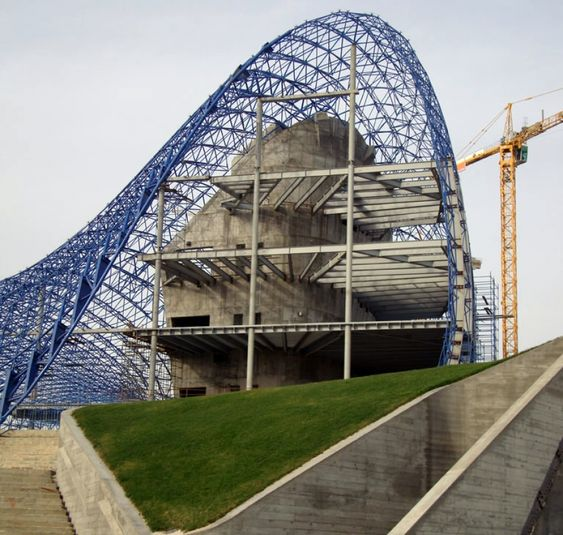
Source: Pinterest
Space frame: Advantages
- The space frame structure is very sturdy and lightweight. For this reason, this provides the most precise and even load distribution.
- The space frame is quite versatile compared to any other structural frame.
- As there are lots of prefabricated parts, it is easier to install the overall structure.
- Space frame buildings are known as portable buildings and they are easily manageable too.
- Good cambering facilities are available in the space frame.
- Purlins are not necessary.
- Without any column, space frame buildings can give good explicit terms.
- Even in low altitudes, space frames can have a wide spawn.
- The space frame is good for any larger-span construction
- If there is a plan for irregular plan-shaped construction or building, a space frame is the only best option.
- There is no requirement for geometric stability in a space frame.
Space frame: Disadvantages
- Space frames are ideal for only platforms and roofs because they can be used for long spans without internal structural support.
- Space frame structures necessitate the use of heavy-duty cranes.
- To fit huge prefabricated components effectively, the building of a space frame structure necessitates accurate measuring and handling.
See also about: peb structure
FAQs
What are the components of the space frame?
The main components of the space frame are linear action members and node connectors or joints.
What are the benefits of the space frame?
The space frame can be the most precise structure for large-span structures. Also, it is the only option for creating irregular plan-shaped construction or building.
How is a space frame built?
The space frame is built from interlocking struts in a geometric pattern.
| Got any questions or point of view on our article? We would love to hear from you. Write to our Editor-in-Chief Jhumur Ghosh at [email protected] |
Housing News Desk is the news desk of leading online real estate portal, Housing.com. Housing News Desk focuses on a variety of topics such as real estate laws, taxes, current news, property trends, home loans, rentals, décor, green homes, home improvement, etc. The main objective of the news desk, is to cover the real estate sector from the perspective of providing information that is useful to the end-user.
Facebook: https://www.facebook.com/housing.com/
Twitter: https://twitter.com/Housing
Email: [email protected]
